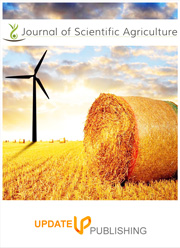Soil physicochemical properties in respect to plant health in Ganodermainfested oil palm plantation
DOI:
https://doi.org/10.25081/jsa.2022.v6.7446Keywords:
Basal stem rot, Ganoderma boninense, oil palm, soil nutrientAbstract
Basal stem rot caused by Ganoderma boninense is a major disease of oil palm in Indonesia. Environmental factors associated with disease can be used as the basis for developing disease control. This study aims to describe the physical and chemical properties of oil palm plantations land mineral soil land that is infested with basal stem rot. Soil composite samples were randomly collected from diseased and healthy palm circle from an oil palm plantation in Mesuji, South Sumatra. The results showed that the texture and nutrient status of diseased and healthy plants were not significantly different, namely they had the same low analytical values in terms of the content of N, C-organic, CEC, Mg, Ca, Na, and K2O. The ratios of C/N, exchangeable K and exchangeable acidity in healthy and diseased soils were both moderate to high. The content of available P and total P was very high (43−134 ppm) and was found to be higher in the soil of diseased plants than in healthy plants. These results indicated that high availability of P nutrients may favor G. boninense infection in oil palm plantation.
Downloads
References
Bande, L. O. S., Wahab, A., Bambang, H., Somowiyarjo, S., & Sunarminto, B. H. (2016). Correlation of physical and chemical soil characteristics with intensity of foot rot disease of black pepper. Jurnal Littri, 22(2), 63-70.
Cepeda, M. C. (2006). Assessing soil microbial populations and activity following the use of microbial inoculationts: Efffects on disease suppressiveness and soil health. Master Thesis, Auburn University.
Directorate General of Estate Crops. (2020). Statistical of National Leading Estate Crops Commodity 2019 – 2021. Retrieved from https://ditjenbun.pertanian.go.id/?publikasi=buku-statistik-perkebunan-2019-2021
Goh, Y. K., Muhammad, Z., Hanifah, M. Z, You, K. G, Qasim, A., & Adeline, S. Y. T. (2020). Determining soil microbial communities and their influence on ganoderma disease incidences in oil palm (Elaeis guineensis) via high-throughput sequencing. Biology, 9(12), 424. https://doi.org/10.3390/biology9120424
Hartono, N. (2013). Pengaruh biaya produksi terhadap pendapatan usaha perkebunan kelapa sawit (Elaeis guineensis Jacq) di Desa Bukit Raya Kecamatan Sepaku Kabupaten Penajam Paser Utara. EPP, 10(1), 20-27.
Hushiarian, R., Yusof, N. A., & Dutse, S. W. (2013). Detection and control of Ganoderma boninense: strategies and perspectives. SpringerPlus, 2, 555. https://doi.org/10.1186/2193-1801-2-555
Janvier, C., Villeneuve, F., Alabouvette, C., Edel-Hermann, V., Mateille, T., & Steinberg, C. (2007). Soil health through soil disease suppression: Which strategy from descriptors to indicators? Soil Biology and Biochemistry, 39(1), 1-23. https://doi.org/10.1016/j.soilbio.2006.07.001
Kamu, A., Chong, K. P., Idris, A. S, Darmesah, G., & Ho, C. M. (2021). Estimating the yield loss of oil palm due to ganoderma basal stem rot disease by using Bayesian model averaging. Journal of Oil Palm Research, 33(1), 46-55. https://doi.org/10.21894/jopr.2020.0061
Lisnawita, Hanum, H., & Tantawi, A. R. (2016). Survey of basal stem rot disease on oil palms (Elaeis guineensis Jacq.) in Kebun Bukit Kijang, North Sumatera, Indonesia. IOP Conference Series: Earth and Environmental Science, 41, 012007. https://doi.org/10.1088/1755-1315/41/1/012007
Nadhrah, N. I., Nulit, R., & Nurrashyeda, R. (2015). Effect of formulated bioorganic containing Burkholderia GanoEB2 in suppressing Ganoderma disease in oil palm seedlings. Plant Protection Science, 51(2), 80-87. https://doi.org/10.17221/26/2014-PPS
Nazari, Y.cA. (2020). The conditions of nutrient status in soil and leaf elements of oil palm (Elaeis guineensis Jacq.) in BPSBP Kalimantan Selatan. Ziraa’ah, 45(3), 274-284.
Purba, J. H. V., & Sipayung, T. (2017). Perkebunan kelapa sawit indonesia dalam perspektif pembangunan berkelanjutan. Jurnal Masyarakat Indonesia, 43(1), 81-94.
Purnama, M. I., Prihatna, C., Gunawan, A. W., & Suwanto, A. (2012). Isolasi dan identifikasi secara molekuler Ganoderma spp. yang berasosiasi dengan penyakit busuk pangkal batang di kelapa sawit. Jurnal Fitopatologi Indonesia, 8(1), 9-15.
Puspika, M. A., & Pinem, M. I. (2018). The physical and chemical soil properties of the soil suppresive to existence of Ganoderma boninense on the oil palm. Jurnal Online Agroekoteknologi, 6(2), 356-361.
Semangun, H. (2000). Penyakit-Penyakit Tanaman Perkebunan di Indonesia. Yogyakarta, Indonesia: Gadjah Mada University Press.
Soil Research Institute. (2009). Technical quidance – second edition: Chemical analyses of soils, plants, waters, and fertilizers. Retrieved from https://balittanah.litbang.pertanian.go.id/ind/dokumentasi/juknis/juknis_kimia2.pdf
Susanto, A., Prasetyo, A. E., & Wening, S. (2013). Infection rate of Ganoderma at four soil texture classes. Jurnal Fitopatologi Indonesia, 9(2), 39-46. https://doi.org/10.14692/jfi.9.2.39
Turner, P. D. (1981). Oil Palm Diseases and Disorders. Oxford, UK: Oxford University Press.
United States Department of Agriculture. (1987). Soil mechanics level 1 - Module 3 - USDA Soil textural classification study guide. USDA Soil Conservation Service. Retrieved from https://www.nrcs.usda.gov/Internet/FSE_DOCUMENTS/stelprdb1044818.pdf
Published
How to Cite
Issue
Section
Copyright (c) 2022 Shervinia Dwi Ayundra, Suwandi Suwandi, Siti Herlinda, Harman Hamidson, Ruli Wandri, Dwi Asmono

This work is licensed under a Creative Commons Attribution-NonCommercial-NoDerivatives 4.0 International License.



 .
.